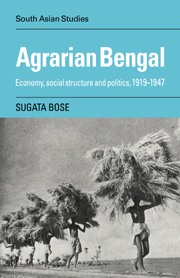Book contents
- Frontmatter
- Contents
- List of maps
- Preface
- List of abbreviations
- PART I AGRARIAN ECONOMY AND SOCIETY: STRUCTURE AND TRENDS
- 1 Introduction: A typology of agrarian social structure in early twentieth-century Bengal
- 2 Subsistence and the market I
- 3 Subsistence and the market II: The peasants' produce
- 4 The peasantry in debt: The working and rupture of systems of rural credit relations
- 5 Peasants into proletarians? The market in land and the question of change in the social organisation of production
- PART II PEASANTS AND POLITICS
- Conclusion
- Glossary
- Select bibliography
- Index
3 - Subsistence and the market II: The peasants' produce
from PART I - AGRARIAN ECONOMY AND SOCIETY: STRUCTURE AND TRENDS
Published online by Cambridge University Press: 24 October 2009
- Frontmatter
- Contents
- List of maps
- Preface
- List of abbreviations
- PART I AGRARIAN ECONOMY AND SOCIETY: STRUCTURE AND TRENDS
- 1 Introduction: A typology of agrarian social structure in early twentieth-century Bengal
- 2 Subsistence and the market I
- 3 Subsistence and the market II: The peasants' produce
- 4 The peasantry in debt: The working and rupture of systems of rural credit relations
- 5 Peasants into proletarians? The market in land and the question of change in the social organisation of production
- PART II PEASANTS AND POLITICS
- Conclusion
- Glossary
- Select bibliography
- Index
Summary
The Bengal peasant's encounter with the market economy was fraught with inequities and uncertainties. The inequities were imposed by a marketing structure, unwieldy in appearance, but highly efficient in short-changing the primary producer. The uncertainties stemmed from wildly fluctuating price levels, determined by the state of demand in remote markets and the exchange value of the Indian currency, which the peasant could neither control nor influence.
In rural Bengal, in a sense it was not so much a case of the peasant going to the market, as of agents of the market coming to his doorstep. It was reported from Rangpur, for instance, in 1926 that ‘almost 75% of most of the important crops find their first market in the houses of the producers themselves’. Small itinerant traders known as paikars in north Bengal and farias elsewhere, or even the slightly bigger men called beparis, travelled from door to door after the crops had been harvested, buying from individual peasant households in small quantities. The peasants did frequent the hats, periodic markets held usually twice a week, where together with small-scale retail trade, some collecting business was done by middlemen for export from the locality. These were scattered in profusion all over the countryside. In the mid-twenties, the average distance between one hat and another was only four miles, and there was one for every 1000 of the male population of 15 years and over.
- Type
- Chapter
- Information
- Agrarian BengalEconomy, Social Structure and Politics, 1919-1947, pp. 70 - 97Publisher: Cambridge University PressPrint publication year: 1987



